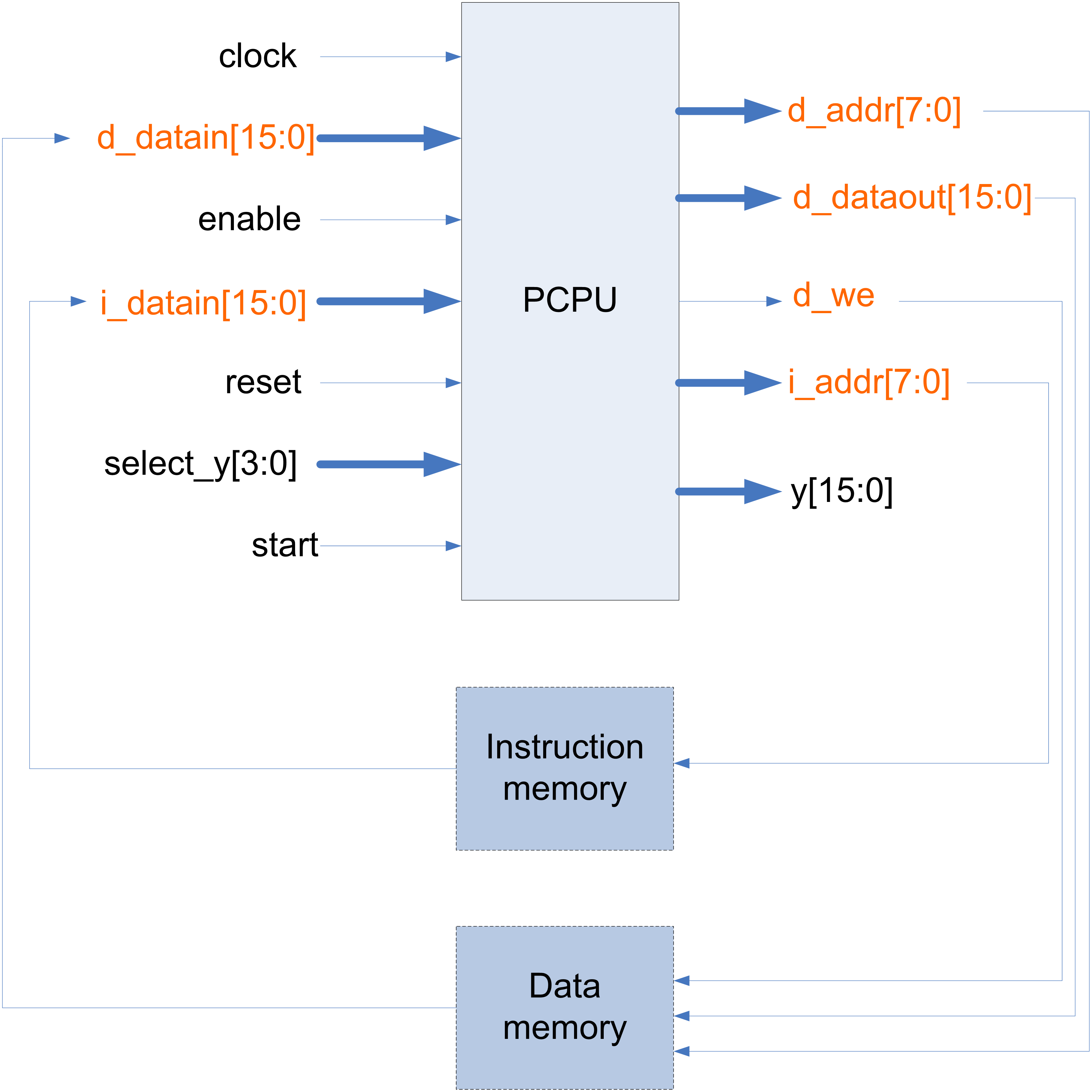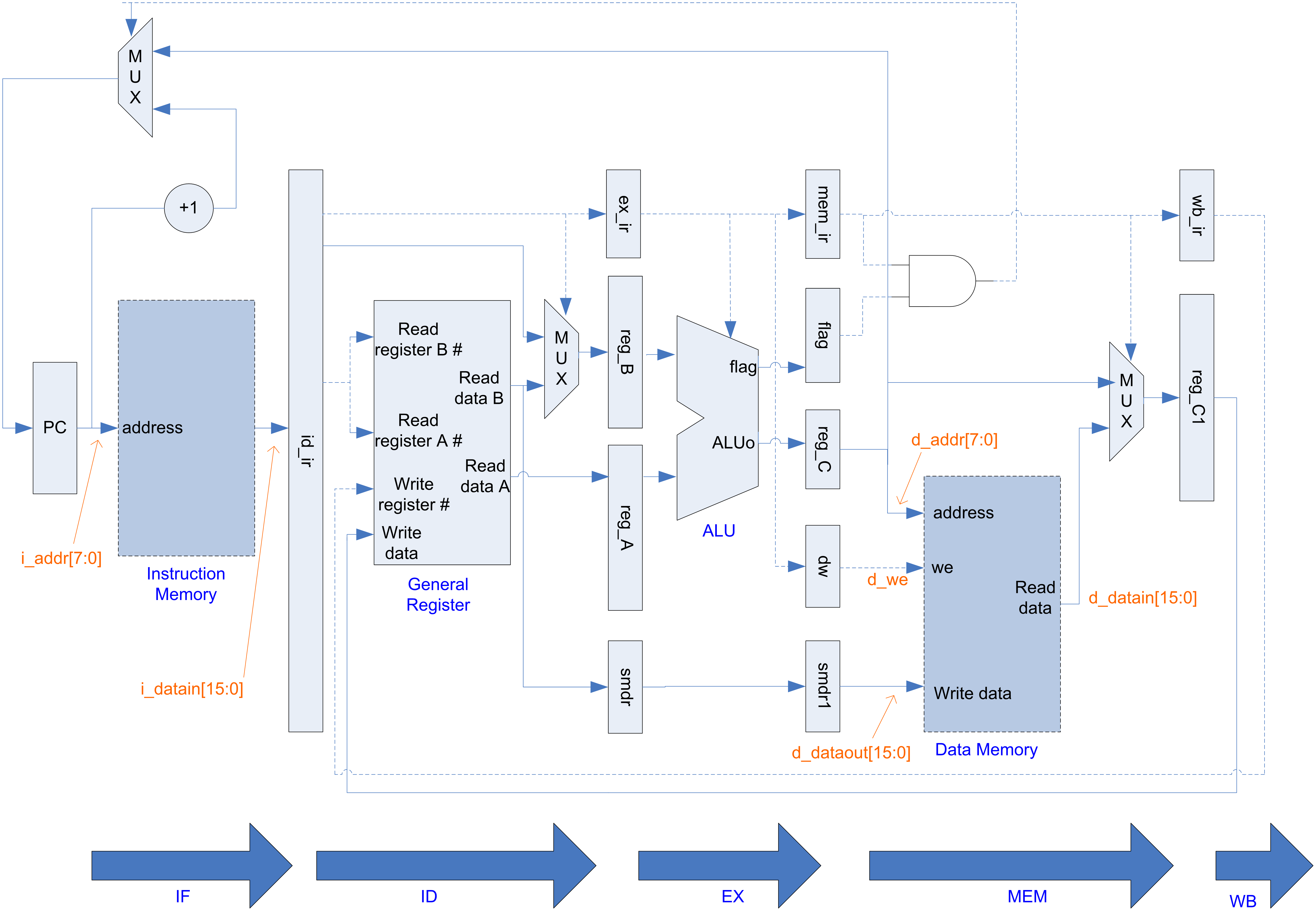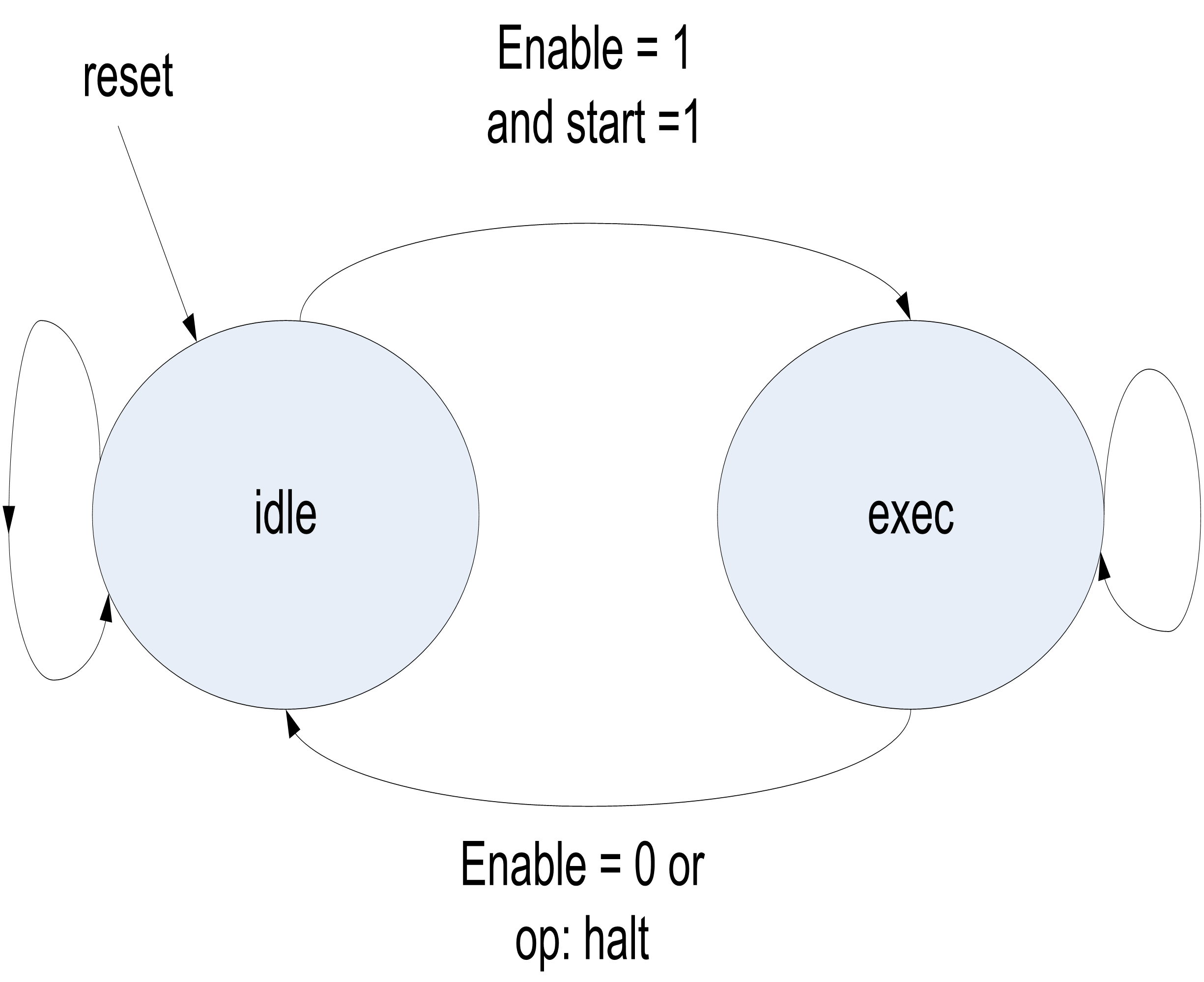verilog实现的16位CPU设计
整体电路图


CPU状态图

idle代表没有工作,exec代表在工作
实验设计思路
五级流水线,增加硬件消耗换取时间的做法。
具体每一部分写什么将由代码部分指明。
完整代码
headfile.v
头文件定义。包含整个工程中的特殊变量定义。后文中只用到gr0到gr3部分,因此该部分没写gr4到gr7,有需要的同学请自行加上。
`ifndef HEADFILE_H_
//State for CPU
`define idle 1'b0
`define exec 1'b1
//Data transfer & Arithmetic
`define NOP 5'b00000
`define HALT 5'b00001
`define LOAD 5'b00010
`define STORE 5'b00011
`define LDIH 5'b10000
`define ADD 5'b01000
`define ADDI 5'b01001
`define ADDC 5'b10001
`define CMP 5'b01100
//Logical / shift
`define AND 5'b01101
`define SLL 5'b00100
`define SLA 5'b00101
//Control
`define JUMP 5'b11000
`define JMPR 5'b11001
`define BZ 5'b11010
`define BNZ 5'b11011
`define BN 5'b11100
`define BC 5'b11110
//Add by myself
`define SUB 5'b01010
`define SUBI 5'b01011
`define SUBC 5'b10010
`define OR 5'b01110
`define XOR 5'b01111
`define SRL 5'b00110
`define SRA 5'b00111
`define BNN 5'b11101
`define BNC 5'b11111
//gr
`define gr0 3'b000
`define gr1 3'b001
`define gr2 3'b010
`define gr3 3'b011
`endif
CPU.v
这个是整个工程的顶层模块。输入100MHz时钟信号,四个开关选择控制七段译码管显示的内容,用button来控制CPU的一次流水线。
首先三个部分的时钟快慢要求不一样。七段译码器的时钟要求最快,要实时显示内容;memory的时钟要求较快,在PCPU下一级流水线到来之前完成数据读写。PCPU模块的时钟要求最慢,这个只是相对前面来说较慢。整个CPU的工作频率是比较快的。
`timescale 1ns / 1ps
module CPU(
input clk,
input enable,
input reset,
input [3:0] SW,
input start,
input button,
output [6:0] light,
output [3:0] en
);
wire PCPU_clk;
wire MEM_clk;
wire LIGHT_clk;
wire [15:0] d_datain;
wire [15:0] i_datain;
wire [3:0] select_y;
wire [7:0] d_addr;
wire [15:0] d_dataout;
wire d_we;
wire [7:0] i_addr;
wire [15:0] y;
clk_div getMEMclk(
.orgin_clk(clk),
.reset(reset),
.div(16'b0100_0000_0000_0000),
.div_clk(MEM_clk)
);
clk_div getLIGHTclk(
.orgin_clk(clk),
.reset(reset),
.div(16'b0010_0000_0000_0000),
.div_clk(LIGHT_clk)
);
PCPUcontroller PCPUctrl(
.myclk(clk),
.button(button),
.reset(reset),
.sense(PCPU_clk)
);
PCPU pcpu(
.clock(PCPU_clk),
.enable(enable),
.reset(reset),
.start(start),
.d_datain(d_datain),
.i_datain(i_datain),
.select_y(SW),
.d_addr(d_addr),
.d_dataout(d_dataout),
.d_we(d_we),
.i_addr(i_addr),
.y(y)
);
I_mem i_mem(
.mem_clk(MEM_clk),
.addr(i_addr),
.rdata(i_datain)
);
D_mem d_mem(
.mem_clk(MEM_clk),
.dwe(d_we),
.addr(d_addr),
.wdata(d_dataout),
.rdata(d_datain)
);
light_show show_light(
.light_clk(LIGHT_clk),
.reset(reset),
.y(y),
.light(light),
.en(en)
);
endmodule
clk_div.v
时钟分频模块,要是开始做CPU设计了还不会时钟分频的话,那我没话说了。不解释,贴代码。
`timescale 1ns / 1ps
module clk_div(
input orgin_clk,
input reset,
input [15:0] div,
output reg div_clk
);
reg [15:0] count;
always@(posedge orgin_clk or posedge reset)
begin
if(reset)
begin
div_clk <= 0;
count <= 0;
end
else
begin
if(count == div)
begin
div_clk <= ~div_clk;
count <= 0;
end
else
count <= count + 1'b1;
end
end
endmodule
PCPUcontroller.v
PCPU模块的状态控制模块。因为用的button来手动控制CPU的流水线,以免时钟太快一下子就跑完了。实现的方法是用状态机,加入trap状态,实现消抖。具体想不明白的话,建议自己画一下状态机转移图,聪明的你一定会明白的。
`timescale 1ns / 1ps
module PCPUcontroller(
input myclk,
input button,
input reset,
output reg sense
);
parameter STOP = 2'b00, INC = 2'b01, TRAP = 2'b10;
reg [1:0] state, nextstate;
always@(posedge myclk or posedge reset)
begin
if(reset)
state <= STOP;
else
state <= nextstate;
end
always@(*)
begin
case(state)
STOP:
if(button) nextstate <= INC;
else nextstate <= STOP;
INC: nextstate <= TRAP;
TRAP:
if(button) nextstate <= TRAP;
else nextstate <= STOP;
default: nextstate <= STOP;
endcase
end
always@(*)
begin
if(reset)
sense <= 0;
else
case(state)
INC: sense <= 1'b1;
default: sense <= 1'b0;
endcase
end
endmodule
PCPU.v
整个工程中最核心的部分。注释部分是冲突处理之后的。如不需要冲突处理,把注释部分指明的代码注释掉即可。对应于前图中的五级流水线,该部分的代码亦分为五部分,请自行研啃。
`timescale 1ns / 1ps
`include"headfile.v"
module PCPU(
input clock,
input enable,
input reset,
input start,
input [15:0] d_datain,
input [15:0] i_datain,
input [3:0] select_y,
output wire [7:0] d_addr,
output wire [15:0] d_dataout,
output wire d_we,
output wire [7:0] i_addr,
output reg [15:0] y
);
reg state;
reg [7:0] pc;
reg [15:0] id_ir;
reg [15:0] ex_ir, reg_A, reg_B, smdr;
reg [15:0] mem_ir, reg_C, smdr1; reg dw; reg flag; reg [15:0] ALUo;reg zf, nf, cf;
reg [15:0] wb_ir, reg_C1;
reg [15:0] gr[0:7];
assign d_dataout = smdr1;
assign d_we = dw;
assign d_addr = reg_C[7:0];
assign i_addr = pc;
/*******CPUcontrol**********************/
reg nextstate;
always@(posedge clock or posedge reset)
begin
if(reset)
state <= `idle;
else
state <= nextstate;
end
always@(*)
begin
case(state)
`idle:
if((enable == 1'b1) && (start == 1'b1))
nextstate <= `exec;
else
nextstate <= `idle;
`exec:
if((enable == 1'b0) || (wb_ir[15:11] == `HALT))
nextstate <= `idle;
else
nextstate <= `exec;
endcase
end
/***************************************/
/****************IF*********************/
always@(posedge clock or posedge reset)
begin
if(reset)
begin
id_ir <= 16'b0000_0000_0000_0000;
pc <= 8'b0000_0000;
end
else if(state == `exec)
begin
/*************Hazard*******************/
if((id_ir[15:11] == `LOAD)
&&(i_datain[15:11] == `ADD)
&&((id_ir[10:8] == i_datain[7:4])
||(id_ir[10:8] == i_datain[3:0])))
begin
id_ir <= 16'bxxxx_xxxx_xxxx_xxxx;
pc <= pc;
end
/**************************************/
else
begin
id_ir <= i_datain;
if(((mem_ir[15:11] == `BZ) && (zf == 1'b1))
||((mem_ir[15:11] == `BN) && (nf == 1'b1))
||((mem_ir[15:11] == `BC) && (cf == 1'b1))
||((mem_ir[15:11] == `BNZ) && (zf == 1'b1))
||((mem_ir[15:11] == `BNN) && (nf == 1'b1))
||((mem_ir[15:11] == `BNZ) && (cf == 1'b1)))
pc <= reg_C[7:0];
else if((mem_ir[15:11] == `JUMP)
||(mem_ir[15:11] == `JMPR))
pc <= reg_C[7:0];
else
pc <= pc + 1'b1;
end
end
else
begin
pc <= pc;
id_ir <= id_ir;
end
end
/***************************************/
/****************ID*********************/
always@(posedge clock or posedge reset)
begin
if(reset)
begin
ex_ir <= 16'b0000_0000_0000_0000;
reg_A <= 16'b0000_0000_0000_0000;
reg_B <= 16'b0000_0000_0000_0000;
smdr <= 16'b0000_0000_0000_0000;
end
else if(state == `exec)
begin
ex_ir <= id_ir;
if(id_ir[15:11] == `STORE) //for Hazard Mode
smdr <= ALUo;
//reg_A
/********************Hazard**********************/
if(wb_ir[15:11] == `LOAD && id_ir[7:4] == wb_ir[10:8])
reg_A <= reg_C1;
else if(mem_ir[15:11] == `LOAD && id_ir[7:4] == mem_ir[10:8])
reg_A <= d_datain;
else if(ex_ir[15:11] != `LOAD && id_ir[7:4] == ex_ir[10:8])
reg_A <= ALUo;
else if(mem_ir[15:11] != `LOAD && id_ir[7:4] == mem_ir[10:8])
reg_A <= reg_C;
else if(wb_ir[15:11] != `LOAD && id_ir[7:4] == wb_ir[10:8])
reg_A <= reg_C1;
else
begin
/***********************************************/
if((id_ir[15:11] == `BZ)
||(id_ir[15:11] == `BN)
||(id_ir[15:11] == `JMPR)
||(id_ir[15:11] == `BC)
||(id_ir[15:11] == `BNZ)
||(id_ir[15:11] == `BNN)
||(id_ir[15:11] == `BNC)
||(id_ir[15:11] == `ADDI)
||(id_ir[15:11] == `SUBI)
||(id_ir[15:11] == `LDIH))
reg_A <= gr[(id_ir[10:8])];
else
reg_A <= gr[(id_ir[6:4])];
end
//reg_B
/********************Hazard*********************/
if(wb_ir[15:11] == `LOAD && id_ir[3:0] == wb_ir[10:8])
reg_B <= reg_C1;
else if(mem_ir[15:11] == `LOAD && id_ir[3:0] == mem_ir[10:8])
reg_B <= d_datain;
else if(ex_ir[15:11] != `LOAD && id_ir[3:0] == ex_ir[10:8])
reg_B <= ALUo;
else if(mem_ir[15:11] != `LOAD && id_ir[3:0] == mem_ir[10:8])
reg_B <= reg_C;
else if(wb_ir[15:11] != `LOAD && id_ir[3:0] == wb_ir[10:8])
reg_B <= reg_C1;
else
begin
/***********************************************/
if((id_ir[15:11] == `LOAD)
||(id_ir[15:11] == `SLL)
||(id_ir[15:11] == `SLA)
||(id_ir[15:11] == `SRL)
||(id_ir[15:11] == `SRA))
reg_B <= {12'b0000_0000_0000, id_ir[3:0]};
else if((id_ir[15:11] == `BZ)
||(id_ir[15:11] == `BN)
||(id_ir[15:11] == `JUMP)
||(id_ir[15:11] == `JMPR)
||(id_ir[15:11] == `BC)
||(id_ir[15:11] == `BNZ)
||(id_ir[15:11] == `BNN)
||(id_ir[15:11] == `BNC)
||(id_ir[15:11] == `ADDI))
reg_B <= {8'b0000_0000, id_ir[7:0]};
else if((id_ir[15:11] == `STORE))
begin
reg_B <= {12'b0000_0000_0000, id_ir[3:0]};
//smdr <= gr[(id_ir[10:8])]; //for not Hazard
end
else if(id_ir[15:11] == `LDIH)
reg_B <= {id_ir[7:0], 8'b0000_0000};
else
reg_B <= gr[id_ir[2:0]];
end
end
else
begin
ex_ir <= ex_ir;
reg_A <= reg_A;
reg_B <= reg_B;
smdr <= smdr;
end
end
/***************************************/
/****************EX*********************/
always@(posedge clock or posedge reset)
begin
if(reset)
begin
mem_ir <= 16'b0000_0000_0000_0000;
reg_C <= 16'b0000_0000_0000_0000;
smdr1 <= 16'b0000_0000_0000_0000;
zf <= 1'b0;
nf <= 1'b0;
cf <= 1'b0;
dw <= 1'b0;
end
else if(state == `exec)
begin
mem_ir <= ex_ir;
reg_C <= ALUo;
cf <= cf_temp;
if((ex_ir[15:11] == `ADD)
||(ex_ir[15:11] == `CMP)
||(ex_ir[15:11] == `ADDI)
||(ex_ir[15:11] == `SUB)
||(ex_ir[15:11] == `SUBI)
||(ex_ir[15:11] == `LDIH)
||(ex_ir[15:11] == `SLL)
||(ex_ir[15:11] == `SRL)
||(ex_ir[15:11] == `SLA)
||(ex_ir[15:11] == `SRA)
||(ex_ir[15:11] == `ADDC)
||(ex_ir[15:11] == `SUBC))
begin
if(ALUo == 16'b0000_0000_0000_0000)
zf <= 1'b1;
else
zf <= 1'b0;
if(ALUo[15] == 1'b1)
nf <= 1'b1;
else
nf <= 1'b0;
end
else if(ex_ir[15:11] == `STORE)
begin
dw <= 1'b1;
smdr1 <= smdr;
end
end
else
begin
reg_C <= reg_C;
smdr1 <= smdr1;
dw <= dw;
end
end
//ALU
reg cf_temp;
always@(*)
begin
if(state == `exec)
begin
if(reset)
begin
ALUo <= 16'b0000_0000_0000_0000;
cf_temp <= 0;
end
else
case(ex_ir[15:11])
`NOP: {cf_temp, ALUo} <= {cf_temp, ALUo};
`HALT: {cf_temp, ALUo} <= {cf_temp, ALUo};
`AND: {cf_temp, ALUo} <= {cf_temp, reg_A & reg_B};
`OR: {cf_temp, ALUo} <= {cf_temp, reg_A | reg_B};
`XOR: {cf_temp, ALUo} <= {cf_temp, reg_A ^ reg_B};
`SLL: {cf_temp, ALUo} <= {cf_temp, reg_A << reg_B};
`SRL: {cf_temp, ALUo} <= {cf_temp, reg_A >> reg_B};
`SLA: {cf_temp, ALUo} <= {cf_temp, reg_A <<< reg_B};
`SRA: {cf_temp, ALUo} <= {cf_temp, reg_A >>> reg_B};
`JUMP: {cf_temp, ALUo} <= {cf_temp, reg_B};
`LDIH: {cf_temp, ALUo} <= {1'b0 + reg_A} + {1'b0 + reg_B};
`ADD: {cf_temp, ALUo} <= {1'b0 + reg_A} + {1'b0 + reg_B};
`ADDI: {cf_temp, ALUo} <= {1'b0 + reg_A} + {1'b0 + reg_B};
`ADDC: {cf_temp, ALUo} <= {1'b0 + reg_A} + {1'b0 + reg_B} + cf;
`SUB: {cf_temp, ALUo} <= {1'b0 + reg_A} - {1'b0 + reg_B};
`SUBI: {cf_temp, ALUo} <= {1'b0 + reg_A} - {1'b0 + reg_B};
`SUBC: {cf_temp, ALUo} <= {1'b0 + reg_A} - {1'b0 + reg_B} - cf;
`CMP: {cf_temp, ALUo} <= {1'b0 + reg_A} - {1'b0 + reg_B};
`LOAD: begin ALUo <= reg_A + reg_B; cf_temp <= cf_temp; end
`STORE: begin ALUo <= reg_A + reg_B; cf_temp <= cf_temp; end
`JMPR: begin ALUo <= reg_A + reg_B; cf_temp <= cf_temp; end
`BZ: begin ALUo <= reg_A + reg_B; cf_temp <= cf_temp; end
`BNZ: begin ALUo <= reg_A + reg_B; cf_temp <= cf_temp; end
`BN: begin ALUo <= reg_A + reg_B; cf_temp <= cf_temp; end
`BNN: begin ALUo <= reg_A + reg_B; cf_temp <= cf_temp; end
`BC: begin ALUo <= reg_A + reg_B; cf_temp <= cf_temp; end
`BNC: begin ALUo <= reg_A + reg_B; cf_temp <= cf_temp; end
default: {cf_temp, ALUo} <= {cf_temp, ALUo};
endcase
end
end
/***************************************/
/***************MEM*********************/
always@(posedge clock or posedge reset)
begin
if(reset)
begin
reg_C1 <= 16'b0000_0000_0000_0000;
wb_ir <= 16'b0000_0000_0000_0000;
end
else if(state == `exec)
begin
wb_ir <= mem_ir;
if(mem_ir[15:11] == `LOAD)
reg_C1 <= d_datain;
else
reg_C1 <= reg_C;
end
end
/***************************************/
/****************WB********************/
always@(posedge clock or posedge reset)
begin
if(reset)
begin
gr[0] <= 16'b0000_0000_0000_0000;
gr[1] <= 16'b0000_0000_0000_0000;
gr[2] <= 16'b0000_0000_0000_0000;
gr[3] <= 16'b0000_0000_0000_0000;
gr[4] <= 16'b0000_0000_0000_0000;
gr[5] <= 16'b0000_0000_0000_0000;
gr[6] <= 16'b0000_0000_0000_0000;
gr[7] <= 16'b0000_0000_0000_0000;
end
else if(state == `exec)
begin
if((wb_ir[15:11] == `LOAD)
||(wb_ir[15:11] == `ADD)
||(wb_ir[15:11] == `ADDI)
||(wb_ir[15:11] == `ADDC)
||(wb_ir[15:11] == `SUB)
||(wb_ir[15:11] == `SUBI)
||(wb_ir[15:11] == `SUBC)
||(wb_ir[15:11] == `AND)
||(wb_ir[15:11] == `OR)
||(wb_ir[15:11] == `XOR)
||(wb_ir[15:11] == `SLL)
||(wb_ir[15:11] == `SRL)
||(wb_ir[15:11] == `SLA)
||(wb_ir[15:11] == `SRA)
||(wb_ir[15:11] == `LDIH))
gr[wb_ir[10:8]] <= reg_C1;
end
else
begin
end
end
/***************************************/
/**************select Y*****************/
always@(*)
begin
case(select_y)
4'b0000: y <= reg_C;
4'b0001: y <= reg_A;
4'b0010: y <= reg_B;
4'b0011: y <= {pc, 8'b0000_0000};
4'b0100: y <= id_ir;
4'b0101: y <= smdr;
4'b0110: y <= reg_C1;
4'b0111: y <= smdr1;
4'b1000: y <= ex_ir;
4'b1001: y <= mem_ir;
4'b1010: y <= wb_ir;
default: y <= reg_C;
endcase
end
/***************************************/
endmodule
I_mem.v
指令存储区域。把指令写在这一部分,即可让CPU跑指定的指令。
`timescale 1ns / 1ps
`include"headfile.v"
module I_mem(
input mem_clk,
input [7:0] addr,
output wire [15:0] rdata
);
reg [15:0] i_mem [255:0];
assign rdata = i_mem[addr];
always@(posedge mem_clk)
begin
case(addr)
0: i_mem[addr] <= {`ADDI, `gr1, 4'b1010, 4'b1011};
1: i_mem[addr] <= {`LDIH, `gr2, 4'b0011, 4'b1100};
2: i_mem[addr] <= {`ADD, `gr3, 1'b0, `gr1, 1'b0, `gr2};
3: i_mem[addr] <= {`STORE, `gr3, 1'b0, `gr0, 4'b0000};
4: i_mem[addr] <= {`ADDI, `gr1, 4'b0001, 4'b0001};
5: i_mem[addr] <= {`LDIH, `gr2, 4'b0001, 4'b0001};
6: i_mem[addr] <= {`ADD, `gr3, 1'b0, `gr1, 1'b0, `gr2};
7: i_mem[addr] <= {`STORE, `gr3, 1'b0, `gr0, 4'b0001};
8: i_mem[addr] <= {`LOAD, `gr1, 1'b0, `gr0, 4'b0000};
9: i_mem[addr] <= {`LOAD, `gr2, 1'b0, `gr0, 4'b0001};
10: i_mem[addr] <= {`ADD, `gr3, 1'b0, `gr1, 1'b0, `gr2};
11: i_mem[addr] <= {`STORE, `gr3, 1'b0, `gr0, 4'b0001};
12: i_mem[addr] <= {`JUMP, 4'b0000, 4'b0010, 4'b1000};
13: i_mem[addr] <= {`ADDI, `gr1, 4'b1010, 4'b1011};
40: i_mem[addr] <= {`HALT, 11'b000_0000_0000};
default: i_mem[addr] <= {`NOP, 11'b000_0000_0000};
endcase
end
endmodule
D_mem.v
数据存储区域。结构简单,根据dwe信号来决定是读取还是写入。
`timescale 1ns / 1ps
`include"headfile.v"
module D_mem(
input mem_clk,
input dwe,
input [7:0] addr,
input [15:0] wdata,
output wire [15:0] rdata
);
reg [15:0] d_mem [255:0];
assign rdata = d_mem[addr];
always@(posedge mem_clk)
begin
if(dwe)
d_mem[addr] <= wdata;
end
endmodule
light_show.v
七段译码管显示模块。
`timescale 1ns / 1ps
module light_show(
input light_clk,
input reset,
input [15:0] y,
output reg [6:0] light,
output reg [3:0] en
);
reg [1:0] dp;
reg [3:0] four;
always@(posedge light_clk or posedge reset)
begin
if(reset)
dp <= 0;
else
begin
dp <= dp + 1'b1;
end
end
always@(*)
begin
if(reset)
begin
four <= 0;
en <= 0;
end
else
begin
case(dp)
0: begin four <= y[3:0]; en <= 4'b1110; end
1: begin four <= y[7:4]; en <= 4'b1101; end
2: begin four <= y[11:8]; en <= 4'b1011; end
3: begin four <= y[15:12]; en <= 4'b0111; end
default: begin four <= 0; en <= 0; end
endcase
end
end
always@(*)
begin
if(reset)
begin
light <= 7'b0001000;
end
else
begin
case(four)
0: light <= 7'b0000001;
1: light <= 7'b1001111;
2: light <= 7'b0010010;
3: light <= 7'b0000110;
4: light <= 7'b1001100;
5: light <= 7'b0100100;
6: light <= 7'b0100000;
7: light <= 7'b0001111;
8: light <= 7'b0000000;
9: light <= 7'b0000100;
4'b1010: light <= 7'b0001000;
4'b1011: light <= 7'b1100000;
4'b1100: light <= 7'b0110001;
4'b1101: light <= 7'b1000010;
4'b1110: light <= 7'b0110000;
4'b1111: light <= 7'b0111000;
default: light <= 7'b0000001;
endcase
end
end
endmodule
VTF_CPU.v
仿真测试文件。
`timescale 1ns / 1ps
module VTF_CPU;
// Inputs
reg clk;
reg enable;
reg reset;
reg [3:0] SW;
reg start;
reg button;
// Outputs
wire [6:0] light;
wire [3:0] en;
// Instantiate the Unit Under Test (UUT)
CPU uut (
.clk(clk),
.enable(enable),
.reset(reset),
.SW(SW),
.start(start),
.button(button),
.light(light),
.en(en)
);
initial begin
// Initialize Inputs
clk = 0;
enable = 0;
reset = 0;
SW = 0;
start = 0;
button = 0;
// Wait 100 ns for global reset to finish
#100;
$display("pc: id_ir :reg_A:reg_B:reg_C:da:dd: :w:reC1:gr1 :gr2 : gr3");
$monitor("%h:%b:%h:%h:%h:%h:%h:%b:%h:%h:%h:%h",
uut.pcpu.pc, uut.pcpu.id_ir, uut.pcpu.reg_A, uut.pcpu.reg_B, uut.pcpu.reg_C,
uut.d_addr, uut.d_dataout, uut.d_we, uut.pcpu.reg_C1, uut.pcpu.gr[1], uut.pcpu.gr[2], uut.pcpu.gr[3]);
enable <= 0; start <= 0;
// Add stimulus here
#10 reset <= 1;
#10 reset <= 0;
#10 enable <= 1;
#10 start <=1;
//#10 start <= 0;
#100;
end
always #20 button = ~button;
always #5 clk = ~clk;
endmodule